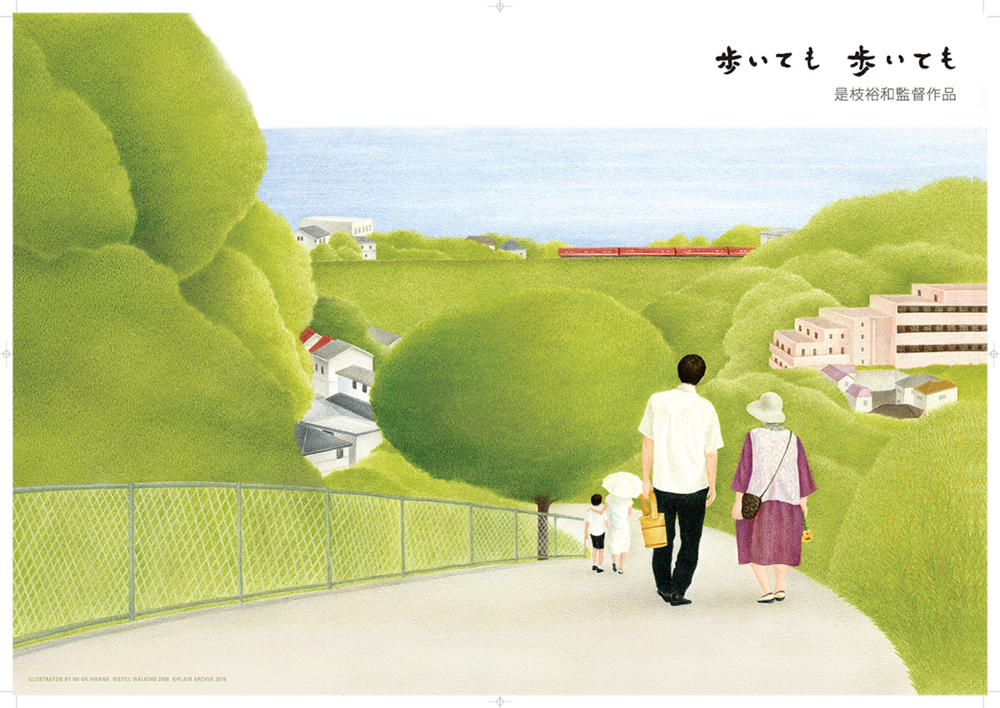
(Image: Plain Archive)
By Cheuk Yiu Chan
Introduction
The meaning of the sublime according to Edward Hirsch refers to use of language and description that excites thoughts and emotions beyond ordinary experience. Though often associated with scale and grandeur, the sublime may also refer to the grotesque or other extraordinary experiences that take us beyond ourselves (1). The qualities of the sublime are captured visually and viscerally in the awe inspiring renditions seen in the romantic style of painting and poetry in the 19th century. Romanticism speaks of nature and revels in its uncontrollable, incalculable forces, and at the root of this mode of expression is a deep interest in the human emotional state, and the state of being. There is a case however, such with the film Still Walking, where ideas of the sublime are not expressed through scale and ferocity, but rather paradoxically, through the banal and dormant aspects of everyday life. This paper will attempt to explore the ways in which elements of the banal and the ordinary were used to express the sublime qualities of the non-physical; death, memory, and time.
The film Still Walking was set in Kanagawa, Japan, in 2008. The director of the film is Kore-eda Hirokazu, and the story was written following the death of his mother and is primarily inspired by memories of their relationship (2). The film portrays the events that take place during an annual family gathering that commemorates the tragic death of a family member, the protagonist’s elder brother. The entire film is based around a single day, which sees the coming together of the main characters, including the protagonist Ryota (Abe Hiroshi), his wife (Yui Natsukawa), his father (Yoshio Harada), mother (Kiki Kirin).
Death and the sublime
In his discussion surrounding ideas of the sublime and the beautiful, Edmund Burke describes that the sublime is, "whatever is fitted in any sort to excite the ideas of pain and danger... Whatever is in any sort terrible, or is conversant about terrible objects, or operates in a manner analogous to terror” (3). Burke argues that the sublime could be something that is correlated with terror and pain as they are perceived to be the strongest emotions. In Burke’s arguments terror refers to the threat one feels from aspects of life that are obscure and infinite, both certain and uncertain. The terror that Burke speaks of can be found in the ideas surrounding the film “Still Walking”, perhaps most prominently in what can be argued as the main theme behind the film; death. In Still Walking, the narrative explores the ways in which the characters deal with a tragic loss and are ultimately faced with the challenge of accepting mortality as a part of life. The portrayal of death emphasizes the sublime qualities of this phenomenon, despite its non-aesthetic nature, the feeling of terror and uncertainty is not lost within the audience. The sublime is emphasized through death in Still Walking. The difficulty of dealing with burden of death and the search for closure is shown in the mother, particularly in the scene where she is observed chasing a yellow butterfly that made its way into the living room, under the belief that it may carry the spirit of her deceased son (figure 2). In an interview with Hirokazu, the director discusses that death in the film was represented in different signs because audiences cannot experience death visually, but those metaphors act as prophecies for some characters’ death (4). Like the lost son, the butterfly emanates life and innocence, and like death, the butterfly is silent and fleeting. The subtle visual metaphors emphasize the complexity of death, further adding to its elusive qualities and in doing so reaffirming the sublime nature of death in visual form.
Burke also argued that “...life and health, though they put us in a capacity of being affected with pleasure, make no such impression by the simple enjoyment. The passions therefore which are conversant about the preservation of the individual turn chiefly on pain and danger, and they are the most powerful of all the passions (5),” which has a strong connection with a line from the grieving mother; “Blaming him give me something to hold on, or otherwise I lose purpose of living (6).” We can see that pain was embedded deeply into this character. The mother appears to forfeit herself to the pain of losing her son, going so far as to define her resentment towards the boy whom her son saved as the sole purpose of her existence, essentially transforming grief from a temporary phase into a coping mechanism, or perhaps even a passion. The passion spoken of here is characterized by pain and anger and can be closely correlated to Burke’s argument which states that pain and terror are considered the most potent of emotions, and therefore most closely associated with ideas of the sublime.
Memory, place and the sublime
The film is primarily based on the director’s memories of his mother; thus, memory plays an important role in the film. For instance, the death of the eldest son is a memory that is revisited with each annual gathering and made more visceral with familiar sights of the family home, the graveyard, and the streets of the village. Separate scenes are shot at the same location, often at ordinary areas of the village, and often viewed through an identical frame. There is an aesthetic consistency and an intentionality to engrain the vision of a certain scene in the mind of the audience that suggests that an observation of the context is vital to an understanding of the underlying narratives. In an interview Hirokazu describes the film as, “a sandwich” where the character is placed in between the reflection and symbols of life and death (7). It can be argued then, that the reflections and symbols of life and death reside not only in characters but likewise in the physical environment that surrounds them. As we visit the same locations, their meaning begins to change in relation to the changes experienced by the character, memory in this case is more of a connection between the film and the audiences, using the repetition of “places” in the film to plant the seed of an artificial memory. It was mentioned early in the film that the eldest son sacrificed his life to save a stranger from drowning, followed by multiple scenes of his gravestone with the ocean in the background, and it can be understood that there is a connection between the death of son and scenes of the ocean. In the closing scenes, Ryota and his father share words of closure by the sea shore, they notice a beached ship. The ship and the waves could be a metaphor for time and memories; like the waves, time will bring back lost memories, and like the waves, time will eventually take them away (figure 3).
As explained with the case of the ocean, consistency and repetition in the physical environment help the audience experience the changes in state of mind of the characters, particularly with the parents. In the opening scenes the father can be seen standing hesitant at the foot of a bridge, staring at the ocean on the other side. At first the scene seems almost meaningless, until we see the father arrive at the same bridge towards the end of the film, only he chooses to cross it this time with his son at his company (figure 4). The interaction between the character and the built environment is integrated into a metaphor of resolve and closure, and ultimately an acceptance of death.
The film’s tendency to revisit familiar locations under different circumstances emphasizes the role of memory and its effect on the characters. For instance, there are repeated visits to the scene of a shaded staircase that rises through an alley of trees (figure 5). Our first encounter with this setting is with the father who is seen slowly making his way down the stairs, and once more as it is climbed by the son (protagonist) and his new family on their way to the parents’ home. One can argue that the shared act of climbing up and down the long staircase throughout the film may symbolize the weight of the grief carried and shared by the characters as they go about their daily lives following the tragedies of the past. This view is perhaps most clear in the closing scenes of the film which sees the father and wife ascend the staircase one final time before their death and ultimately, their relief. According to Burke, “the torments which we may be made to suffer are much greater in their effect on the body and mind, than any pleasures which the most learned voluptuary could suggest, or than the liveliest imagination, and the most sound and exquisitely sensible body, could enjoy (8).” Hirozaku uses the concept of memory to portray the perpetual torment of grief, which according to Burke, is a more potent method of expressing the ideas of the sublime. There is a depth in the narrative that can be attributed to the Hirokazu’s ability to portray the environment as a physical extension of the narrative, one that grows to be of significance to the viewer, through virtue of time and repetition what was once a space becomes a place.
Conclusion
Throughout Still Walking, Hirokazu uses the characters’ interaction with their physical surroundings as a tool to create a coherence of memories, this use of memory is also found to be an important consideration when it comes to the design of the built environment. Hirokazu used the reoccurrence of specific settings to instill an artificial memory within audience, in doing so the audience can sympathize with the events of the film further. Seeing how the characters inhabit the same places in a different manner and at different times, we are made aware of the changes in the state of mind of each member of the family, in other words, there is a symbolic relationship between the characters and the way in which they inhabit the physical context. Using this relationship, the narrative reaffirms the sublime qualities of death, memory, and time in places and settings that at first glance appear mundane, banal, and far from the conventional understanding of the sublime.
CITATIONS
1. Hirsch, Edward. “A Poet's Glossary”. Houghton Mifflin Harcourt, 2004, p. 618
2. Guillen, Michael. Regrets & Memories: “A Conversation with Hirokazu Kore-Eda”, MUBI, August 28, 2009, https://ift.tt/2Pl3ayb
3. Burke, Edmund. A Philosophical Inquiry into the Origin of Our Ideas of the Sublime and Beautiful. New York: Harper & Brothers Publishers, 1856, p. 51.
4. 24電影誌. “Kore-eda Hirokazu talks about Still Walking.” YouTube video, 25:06. December 17,2018. https://www.youtube.com/watch?v=o14kwRCY7LQ
5. Burke, Edmund. A Philosophical Inquiry into the Origin of Our Ideas of the Sublime and Beautiful. New York: Harper & Brothers Publishers, 1856, p. 50.
6. Hirokazu, Kore-eda. Still Walking, 2008, Kanagawa, Japan; CineQuanon, 2008. DVD.
7. 24電影誌. “Kore-eda Hirokazu talks about Still Walking.” YouTube video, 25:06. December 17,2018. https://www.youtube.com/watch?v=o14kwRCY7LQ
8. Burke, Edmund. A Philosophical Inquiry into the Origin of Our Ideas of the Sublime and Beautiful. New York: Harper & Brothers Publishers, 1856, p. 51.
BIBLIOGRAPHY
Burke, Edmund. A Philosophical Inquiry into the Origin of Our Ideas of the Sublime and Beautiful.New York: Harper & Brothers Publishers, 1856
Guillen, Michael. Regrets & Memories: “A Conversation with Hirokazu Kore-Eda”, MUBI, August 28, 2009. https://ift.tt/2Pl3ayb
Hirokazu, Kore-eda. Still Walking, 2008, Kanagawa, Japan; CineQuanon, 2008. DVD.
Hirsch, Edward. “A Poet's Glossary”. Boston: Houghton Mifflin Harcourt, 2004
24電影誌. “Kore-eda Hirokazu talks about Still Walking.” YouTube video, 25:06. December 17,2018. https://www.youtube.com/watch?v=o14kwRCY7LQ

LOGO DESIGNED BY MEENTS ILLUSTRATED
from REVIEW BLOG - Every Movie Has a Lesson https://ift.tt/2PjxAkl







No comments:
Post a Comment